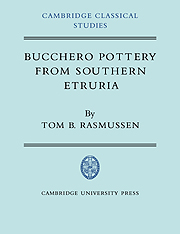Summary
AIMS
Bucchero has been called the national pottery of Etruria (H.B.Walters, History of Ancient Pottery ii (London, 1905), 301). In the archaic period it is a common feature of most Etruscan sites, over an area extending from the river Arno in the north to the river Sele south of Salerno. Within this area there are several regional styles of bucchero, of which the S. Etruscan is the first to be established. In this study ‘S. Etruria’ is applied in a narrow sense to that part of Etruria of which the most important centres are Cerveteri, Veii and Tarquinia. Vulci, which is usually described as a city of S. Etruria, belongs, as far as bucchero pottery is concerned, more to Central Etruria, which includes the area around Lake Bolsena and Orvieto and westwards to the coast (see Chapter 5, and FIGS.427–8). Technically the bucchero of Central and N. Etruria and of Etruscan Campania is inferior to that of S. Etruria: the fabric is generally heavy and the shapes less harmonious. Unlike the relief ware of the North, the bucchero of S. Etruria relies to a great extent on shape alone for its visual appeal. It is often pleasing to the eye, and at its best it has a considerable elegance. But quite apart from this its widespread occurrence in deposits of all types makes its study of considerable value for Etruscan chronology.
- Type
- Chapter
- Information
- Bucchero Pottery from Southern Etruria , pp. 1 - 7Publisher: Cambridge University PressPrint publication year: 1979

